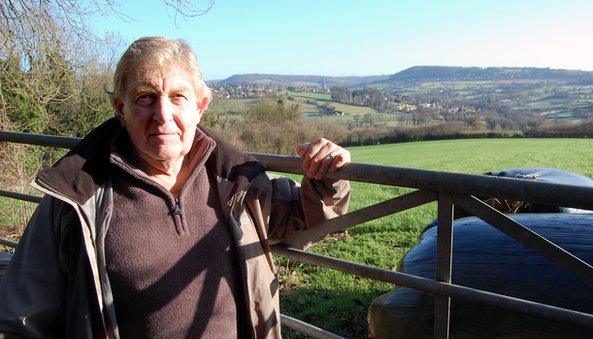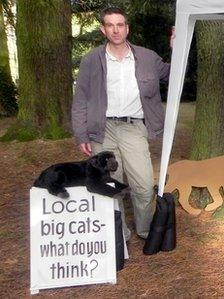'Big cats are out there', say two Gloucestershire trackers
- Published

Frank Tunbridge has dedicated more than 25 years of his life to the research of big cats in the wild
"I've been ridiculed, called deluded, told to get a life and all sorts of things," says 65-year-old semi-retired wildlife enthusiast Frank Tunbridge.
He is passionate about a species of which its mere existence is hotly debated: Wild big cats in the UK.
"I know they are out there," said Mr Tunbridge, who has spent nearly 25 years investigating Gloucestershire's reported big cats.
He said that on average he received two sightings a week from across the county.
His passion is equalled by that of Rick Minter, 50, who has written a book about big cats in the wilds of Britain.
'Own little world'
"The main candidates for the larger types of feral big cats being reported in Britain are puma-type cats and panthers," he said.
"A puma is a sandy-grey coloured cat, also known as cougar and mountain lion. A black panther is biologically a leopard or a jaguar in its black form."
Mr Minter admitted some people just found the idea of big cats roaming wild in the English countryside too incredible to believe.
"You do feel largely like you are beavering away in your own little world," he said.

Rick Minter said he had seen three big cats himself in the wild in England
"Then, suddenly January 2012 comes along and half the nation's media are tracking your every step.
"You're suddenly engulfed with emails and reporters and programmes wanting to know about the latest deer carcass or your view on 'X' in relation to big cats."
The incident he refers to came about when the National Trust announced that it had called for DNA tests to be carried out on a deer carcass found on its land near Stroud, Gloucestershire.
A trust spokesman had initially said the deer's injuries - and way the carcass had been eaten by its killer - were thought to be "highly indicative of big cat activity".
But three weeks later the results are back and they are negative to the idea of a big cat predator. Fox and deer DNA are the only traces found on the swabs taken.
But Mr Tunbridge said he still believed the big cats were out there - and said he had his own close encounter to prove it.
'Jungle cat'
"It was dead quiet," he said, remembering a night he spent tracking wildlife near Minchampton, Stroud, last September.
"You could hear a pin drop, and this big cat growled behind me - just warning me.
"Through my night vision equipment I just saw it swoop down, sweep up a rabbit and disappear into a small wood.
"They are so elusive, so stealthy - especially leopards and pumas - they see you before you see them."
Mr Minter, meanwhile, said he had seen three big cats in the wild - a black panther in Cumbria, a puma-like cat in a Cotswold woodland and a smaller cat, "like a jungle cat", near the River Severn in Gloucester.
Between June 2007 and April 2011, Gloucestershire Police took 38 calls about big cat sightings.

Scientists were unable to match the DNA samples found on two deer carcasses with that of a big cat
According to the force's records, most of the animals were described as large black cats although there was one reported sighting of a lion.
So, why would big cats be found in the far-from-tropical conditions of the Cotswolds?
Both of the big cat hunters said they believed the most likely explanation is that such animals have been released from domestic situations and small private collections.
Following the introduction of the 1976 Dangerous Wild Animals Act, more costly and rigorous conditions were applied for keeping such animals.
Natural England, the government's advisory body on the natural environment, has stated it is confident there is no breeding big cat population in this country.
A spokesman said reports were occasionally received, but no sightings had ever been confirmed and the evidence it had looked at had either been unsubstantiated or attributed to other causes.
'Strong desire'
But this is not the line taken by those who are convinced they have seen, heard or tracked a big cat in the wild.
As for DNA testing of animal carcasses, previous cases have shown up different results, Mr Minter said.
He claimed that in 2003, tests on a black animal hair found after a sighting in Lincolnshire gave positive results for a leopard.
Two years later, DNA results consistent with a puma were found on a hair recovered after sightings in Neath, South Wales.
And in 2009 the <link> <caption>Forestry Commission confirmed</caption> <url href="http://news.bbc.co.uk/1/hi/england/gloucestershire/7814960.stm" platform="highweb"/> </link> that rangers had twice spotted big cats while conducting deer surveys in the Forest of Dean.
"Recent community surveys have indicated a strong desire for big cat evidence to be researched as robustly as possible, and for all aspects of this subject to be considered in a responsible way," added Mr Minter.
"We are coming to a time when we must learn about them."
- Published2 February 2012
- Published18 January 2012
- Published11 January 2012